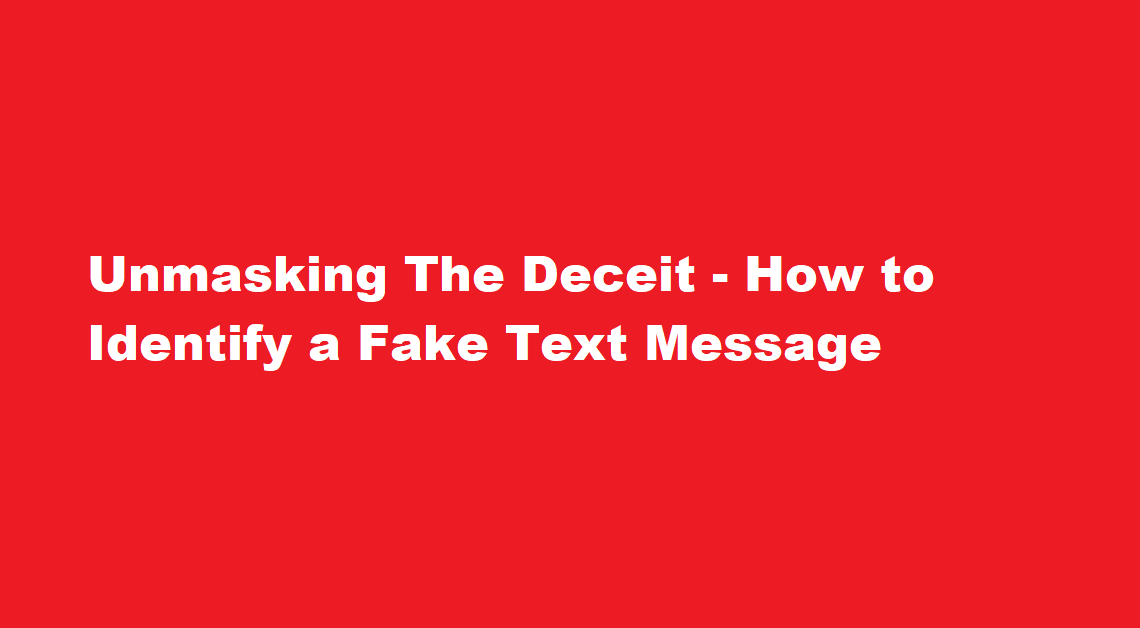Unmasking The Deceit – How to Identify a Fake Text Message


In today’s digital age, text messages have become an integral part of our daily communication. From personal conversations to business transactions, we rely heavily on text messages to convey important information. However, as technology advances, so do the methods used by malicious actors to deceive and defraud individuals. Fake text messages, also known as SMS phishing or smishing, have become a prevalent threat. In this article, we will explore how to identify a fake text message and protect yourself from falling victim to scams.
Pay Attention to the Sender’s Number
The first step in identifying a fake text message is to scrutinize the sender’s phone number. Be wary of messages sent from unfamiliar or suspicious numbers. Scammers often use fake or untraceable numbers to hide their identity. Legitimate organizations usually send text messages from recognizable, official numbers.
Check for Spelling and Grammar Errors
Poor spelling and grammar are common red flags in fake text messages. Scammers may not be proficient in the language used in the message, resulting in obvious errors. Be cautious of messages containing multiple mistakes or awkward sentence structures.
Examine the Content
Authentic messages typically have a clear and concise purpose. If the text message seems vague, lacks specific details, or makes outrageous claims, it’s likely a fake. For example, beware of messages promising lottery winnings, gifts, or prizes from unknown sources.
Be Skeptical of Urgent Requests
Scammers often use urgency to pressure individuals into taking immediate action. Be cautious if the message demands urgent attention or threatens negative consequences unless you comply. Verify the request with the supposed sender through a trusted source before taking any action.
Avoid Clicking on Suspicious Links
Hyperlinks embedded in text messages can lead to phishing websites designed to steal your personal information. Hover over the link without clicking to preview the URL. If the link appears strange or doesn’t match the purported sender’s website, it’s a strong indicator of a fake message.
Verify the Sender’s Identity
When in doubt, contact the sender through an alternative, trusted method to confirm the authenticity of the message. Scammers often impersonate banks, government agencies, or popular brands. Don’t rely solely on the contact information provided in the text message; use official channels.
Check for Unsolicited Attachments
Be cautious of unsolicited attachments, especially if the sender is unknown. Malicious attachments can contain malware that can infect your device and compromise your data.
Review the Message Header
If you have the technical know-how, check the message header for clues. Legitimate messages often include routing information, while fake messages may have unusual or missing headers.
Install Anti-Phishing Apps
There are various mobile apps available that can help identify and block fake text messages. These apps can analyze message content and sender information to determine if it’s a potential scam.
Educate Yourself and Others
Awareness is one of the most effective tools against scams. Stay informed about the latest scams and educate your friends and family about how to identify fake text messages. Encourage open communication so that they can reach out to you if they receive a suspicious message.
Report Suspicious Messages
If you receive a fake text message, report it to your mobile carrier and the appropriate authorities. Reporting scams can help prevent others from falling victim to the same fraudulent activities.
FREQUENTLY ASKED QUESTIONS
What happens if you reply to a fake text?
Directly replying to a spam text message lets a spammer know that your number is genuine. After you reply, they can sell your phone number to other spammers who might bombard you with false promises of free gifts and product offers. Instead, it’s best to block and report the number.
Can text messages be faked?
Fake text messages are unwanted SMS messages often used by scammers to trick you into providing money or personal information. Fake texts can be part of SMS phishing scams (also known as smishing) that can infect your phone with malware or spyware, putting you at risk of fraud and identity theft.
In conclusion, identifying a fake text message requires vigilance, skepticism, and the willingness to take precautions. Scammers continually adapt their tactics, so staying informed and cautious is essential. By following the tips outlined in this article and sharing your knowledge with others, you can protect yourself and your loved ones from falling prey to fake text message scams. Remember that when in doubt, it’s always better to be safe than sorry.
Read Also : A Comprehensive Guide on How to Record on Zoom
Recent Posts
A Step-by-Step Guide to Turning Off Your PS4
Introduction The PlayStation 4 (PS4) has been a gaming staple for millions of gamers worldwide…
How to Get a Receipt from Amazon – A Step-By-Step Guide
Amazon, the world's largest online retailer, offers a convenient and efficient way to shop for…
How to Leave a Group Chat on iPhone – A Step-by-Step Guide
Introduction Group chats are a fantastic way to stay connected with friends, family, or colleagues,…
A Comprehensive Guide on How to Pack a Bowl
Introduction Packing a bowl is a skill that many individuals enjoy mastering, whether for medicinal…
How to Properly Turn Off a Tesla Electric Vehicle
Introduction Tesla electric vehicles (EVs) have revolutionised the automotive industry with their cutting-edge technology and…
The Art of Capturing Majesty – A Step-by-Step Guide on How to Draw an Elephant
Introduction Drawing is a beautiful form of expression that allows us to capture the essence…



